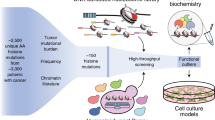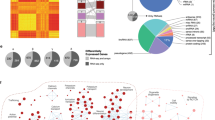Abstract
We used high-resolution SNP genotyping to identify regions of genomic gain and loss in the genomes of 212 medulloblastomas, malignant pediatric brain tumors. We found focal amplifications of 15 known oncogenes and focal deletions of 20 known tumor suppressor genes (TSG), most not previously implicated in medulloblastoma. Notably, we identified previously unknown amplifications and homozygous deletions, including recurrent, mutually exclusive, highly focal genetic events in genes targeting histone lysine methylation, particularly that of histone 3, lysine 9 (H3K9). Post-translational modification of histone proteins is critical for regulation of gene expression, can participate in determination of stem cell fates and has been implicated in carcinogenesis. Consistent with our genetic data, restoration of expression of genes controlling H3K9 methylation greatly diminishes proliferation of medulloblastoma in vitro. Copy number aberrations of genes with critical roles in writing, reading, removing and blocking the state of histone lysine methylation, particularly at H3K9, suggest that defective control of the histone code contributes to the pathogenesis of medulloblastoma.
This is a preview of subscription content, access via your institution
Access options
Subscribe to this journal
Receive 12 print issues and online access
$209.00 per year
only $17.42 per issue
Buy this article
- Purchase on Springer Link
- Instant access to full article PDF
Prices may be subject to local taxes which are calculated during checkout




Similar content being viewed by others
References
Marino, S. Medulloblastoma: developmental mechanisms out of control. Trends Mol. Med. 11, 17–22 (2005).
Reardon, D.A. et al. Extensive genomic abnormalities in childhood medulloblastoma by comparative genomic hybridization. Cancer Res. 57, 4042–4047 (1997).
Bayani, J. et al. Molecular cytogenetic analysis of medulloblastomas and supratentorial primitive neuroectodermal tumors by using conventional banding, comparative genomic hybridization, and spectral karyotyping. J. Neurosurg. 93, 437–448 (2000).
Beroukhim, R. et al. Assessing the significance of chromosomal aberrations in cancer: methodology and application to glioma. Proc. Natl. Acad. Sci. USA 104, 20007–20012 (2007).
Ogawa, H., Ishiguro, K., Gaubatz, S., Livingston, D.M. & Nakatani, Y. A complex with chromatin modifiers that occupies E2F- and Myc-responsive genes in G0 cells. Science 296, 1132–1136 (2002).
Klymenko, T. et al. A Polycomb group protein complex with sequence-specific DNA-binding and selective methyl-lysine-binding activities. Genes Dev. 20, 1110–1122 (2006).
Mullighan, C.G. et al. Genome-wide analysis of genetic alterations in acute lymphoblastic leukaemia. Nature 446, 758–764 (2007).
Weir, B.A. et al. Characterizing the cancer genome in lung adenocarcinoma. Nature 450, 893–898 (2007).
Cloos, P.A. et al. The putative oncogene GASC1 demethylates tri- and dimethylated lysine 9 on histone H3. Nature 442, 307–311 (2006).
Shin, S. & Janknecht, R. Diversity within the JMJD2 histone demethylase family. Biochem. Biophys. Res. Commun. 353, 973–977 (2007).
Shi, Y. et al. Coordinated histone modifications mediated by a CtBP co-repressor complex. Nature 422, 735–738 (2003).
Fodor, B.D. et al. Jmjd2b antagonizes H3K9 trimethylation at pericentric heterochromatin in mammalian cells. Genes Dev. 20, 1557–1562 (2006).
Howe, L. et al. Histone H3 specific acetyltransferases are essential for cell cycle progression. Genes Dev. 15, 3144–3154 (2001).
Lu, J., Ruhf, M.L., Perrimon, N. & Leder, P. A genome-wide RNA interference screen identifies putative chromatin regulators essential for E2F repression. Proc. Natl. Acad. Sci. USA 104, 9381–9386 (2007).
Marino, S., Vooijs, M., van Der Gulden, H., Jonkers, J. & Berns, A. Induction of medulloblastomas in p53-null mutant mice by somatic inactivation of Rb in the external granular layer cells of the cerebellum. Genes Dev. 14, 994–1004 (2000).
Olson, M.V. et al. Transgenic E2F1 expression in the mouse brain induces a human-like bimodal pattern of tumors. Cancer Res. 67, 4005–4009 (2007).
Kenney, A.M., Cole, M.D. & Rowitch, D.H. Nmyc upregulation by sonic hedgehog signaling promotes proliferation in developing cerebellar granule neuron precursors. Development 130, 15–28 (2003).
Knoepfler, P.S., Cheng, P.F. & Eisenman, R.N. N-myc is essential during neurogenesis for the rapid expansion of progenitor cell populations and the inhibition of neuronal differentiation. Genes Dev. 16, 2699–2712 (2002).
Marino, S., Hoogervoorst, D., Brandner, S. & Berns, A. Rb and p107 are required for normal cerebellar development and granule cell survival but not for Purkinje cell persistence. Development 130, 3359–3368 (2003).
Gateff, E., Loffler, T. & Wismar, J. A temperature-sensitive brain tumor suppressor mutation of Drosophila melanogaster: developmental studies and molecular localization of the gene. Mech. Dev. 41, 15–31 (1993).
Trimarchi, J.M., Fairchild, B., Wen, J. & Lees, J.A. The E2F6 transcription factor is a component of the mammalian Bmi1-containing polycomb complex. Proc. Natl. Acad. Sci. USA 98, 1519–1524 (2001).
Leung, C. et al. Bmi1 is essential for cerebellar development and is overexpressed in human medulloblastomas. Nature 428, 337–341 (2004).
Wiederschain, D. et al. Contribution of polycomb homologues Bmi-1 and Mel-18 to medulloblastoma pathogenesis. Mol. Cell. Biol. 27, 4968–4979 (2007).
Cartwright, P., Muller, H., Wagener, C., Holm, K. & Helin, K. E2F–6: a novel member of the E2F family is an inhibitor of E2F-dependent transcription. Oncogene 17, 611–623 (1998).
Panteleeva, I. et al. HP1alpha guides neuronal fate by timing E2F-targeted genes silencing during terminal differentiation. EMBO J. 26, 3616–3628 (2007).
Thomas, T. et al. Monocytic leukemia zinc finger protein is essential for the development of long-term reconstituting hematopoietic stem cells. Genes Dev. 20, 1175–1186 (2006).
Annunziata, C.M. et al. Frequent engagement of the classical and alternative NF-kappaB pathways by diverse genetic abnormalities in multiple myeloma. Cancer Cell 12, 115–130 (2007).
Romer, J.T. et al. Suppression of the Shh pathway using a small molecule inhibitor eliminates medulloblastoma in Ptc1(+/−)p53(−/−) mice. Cancer Cell 6, 229–240 (2004).
Kubicek, S. et al. Reversal of H3K9me2 by a small-molecule inhibitor for the G9a histone methyltransferase. Mol. Cell 25, 473–481 (2007).
Thompson, M.C. et al. Genomics identifies medulloblastoma subgroups that are enriched for specific genetic alterations. J. Clin. Oncol. 24, 1924–1931 (2006).
Acknowledgements
We thank the individuals and families who agreed to take part in these studies. We thank S. Egan, J. Ellis and R. Bremner for critical review of the manuscript. We thank R. Wechsler-Reya (Duke), A.M. Kenney (Memorial-Sloan Kettering) and D. Rowitch (University of California San Francisco) for reagents and helpful discussions. We are grateful to K. Helin (University of Copenhagen) for providing JMJD2C expression constructs. We thank P. Paroutis for artwork and S. Archer for editing. We are grateful to C. Marshall and J. Wei for assistance with copy number analysis. This work was supported by the Canadian Cancer Society and the Pediatric Brain Tumor Foundation. M.D.T. is supported by a Sontag Foundation Distinguished Scholar award. Additional research support was obtained from the Hospital for Sick Children Foundation, The Neurosurgery Research and Education Foundation, BRAINCHILD, the 407 Express Toll Route, and the Walker family. M.D.T. was supported by the Laurie Berman fund in Brain Tumor Research, the American Brain Tumor Association and a Clinician-Scientist award from the Canadian Institutes of Health Research. P.A.N. was supported by a Restracomp salary award from the Hospital for Sick Children.
Author information
Authors and Affiliations
Contributions
P.A.N. coordinated and designed the study, wrote the manuscript, isolated nucleic acids from tumors, performed copy number and LOH analysis and identified regions of interest, validated copy number regions, performed qRT-PCR analyses, generated stable cell lines and retroviruses, and performed in vitro functional assays, immunoblotting, immunofluorescence, and ChIP assays. Y.N. isolated DNA from cell lines, performed copy number and LOH analysis, and validated copy number regions. X.W. built expression constructs and generated stable cell lines. L.F. identified and filtered known CNVs from the datasets. D.W.E. performed FISH and IHC on medulloblastoma TMA. S.C. performed IHC on P7 murine CB and scored medulloblastoma TMAs. S.M. performed GISTIC analysis and validated copy number regions. P.N.K. isolated DNA from tumors, performed copy number and LOH analysis, and validated copy number regions. J.P. built expression constructs, analyzed qRT-PCR data and validated copy number regions. A.D. built expression constructs. Y.S.R. performed mouse experiments. K.Z. validated copy number regions. J.M. performed animal husbandry and mouse experiments. S.W.S. provided technical advice/intellectual contribution. J.S.R. performed statistical analyses. C.G.E. performed IHC on medulloblastoma TMA. W.G., Y.G., B.L., R.G., I.F.P., R.L.H., T.V.M., C.G.C., F.B. and D.B. contributed clinical materials. R.J.G. and J.T.R. provided technical advice, intellectual contribution and helped write the manuscript. M.D.T. designed the study and experiments, interpreted the results, provided supervision, and wrote the manuscript and revisions.
Corresponding author
Supplementary information
Supplementary Text and Figures
Supplementary Figures 1–4, Supplementary Methods and Supplementary Tables 4 and 5 (PDF 10194 kb)
Supplementary Note
Clinical and sample information for the medulloblastoma cohort analyzed by SNP array (XLS 38 kb)
Supplementary Table 1
Known copy number variants identified in the medulloblastoma genome (XLS 267 kb)
Supplementary Table 2
Regions of genomic gain and loss in the medulloblastoma genome (XLS 1799 kb)
Supplementary Table 3
GISTIC analysis of medulloblastoma copy number data (XLS 18 kb)
Supplementary Table 6
List of primers (XLS 11 kb)
Rights and permissions
About this article
Cite this article
Northcott, P., Nakahara, Y., Wu, X. et al. Multiple recurrent genetic events converge on control of histone lysine methylation in medulloblastoma. Nat Genet 41, 465–472 (2009). https://doi.org/10.1038/ng.336
Received:
Accepted:
Published:
Issue Date:
DOI: https://doi.org/10.1038/ng.336
This article is cited by
-
Chromatin-modifying enzymes as modulators of nuclear size during lineage differentiation
Cell Death Discovery (2023)
-
The assembly of mammalian SWI/SNF chromatin remodeling complexes is regulated by lysine-methylation dependent proteolysis
Nature Communications (2022)
-
Pediatric brain tumors: a bibliometric analysis
Child's Nervous System (2022)
-
Histone demethylase KDM4C controls tumorigenesis of glioblastoma by epigenetically regulating p53 and c-Myc
Cell Death & Disease (2021)
-
JMJD2C promotes colorectal cancer metastasis via regulating histone methylation of MALAT1 promoter and enhancing β-catenin signaling pathway
Journal of Experimental & Clinical Cancer Research (2019)



